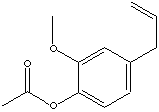PRODUCT IDENTIFICATION

H.S. CODE
TOXICITY
1,3,4-Eugenol acetate; 1-Acetoxy-2-methoxy-4-allylbenzene; 2-Methoxy-4-(2-propen-1-yl)phenyl acetate; 2-Methoxy-4-(2-propenyl)phenyl acetate; 4-Allyl-2-methoxyphenol acetate; 4-Allyl-2-methoxyphenyl acetate; Aceteugenol; Acetyl eugenol; Acetyleugenol; Eugenyl acetate;
CLASSIFICATION
Phenylpropanoid
EXTRA NOTES
PHYSICAL AND CHEMICAL PROPERTIES
MELTING POINT
SOLUBILITY IN WATER
INCOMPATIBILITIES
oxidizing agents
REFRACTIVE INDEX
66 C
EXTERNAL LINKS & GENERAL DESCRIPTION
Drug Information Portal (U.S. National Library of Medicine) - Acetyleugenol
PubChem Compound Summary - Acetyleugenol
KEGG (Kyoto Encyclopedia of Genes and Genomes) - Acetyleugenol
http://www.ebi.ac.uk/chebi/ - Acetyleugenol
http://www.ncbi.nlm.nih.gov/ - Acetyleugenol
Human Metabolome Database - Acetyleugenol
Flavouring Substances Chemical Group 18: Allylhydroxybenzenes
http://www.sciencedirect.com/
In
continuation of our studies with the oil of cloves - a common kitchen
spice and a crude drug for home medicine - we have isolated yet
another active component identified as acetyl eugenol (AE); the
earlier reported active component being eugenol. The isolated material
(IM) was found to be a potent platelet inhibitor; IM abolished arachidonate
(AA)-induced aggregation at ca. 12 μM, a concentration needed to
abolish the second phase of adrenaline-induced aggregation. Chemically
synthesized acetyl eugenol showed similar effects on AA- and adrenaline-induced
aggregation. A dose-dependent inhibition of collagen-induced aggregation
was also observed. AE did not inhibit either calcium ionophore A23187-
or thrombin-induced aggregation. Studies on aggregation and ATP
release were done using whole blood (WB). AA-induced aggregation
in WB was abolished at 3 μg/ml (14.6 μM) which persisted even
after doubling the concentration of AA. ATP release was inhibited.
Inhibition of aggregation appeared to be mediated by a combination
of two effects: reduced formation of thromboxane and increased generation
of 12-lipoxygenase product (12-HPETE). These effects were observed
by exposing washed platelets to (14C)AA or by stimulating AA-labelled
platelets with ionophore A23187. Acetyl eugenol inhibited (14C)TxB2
formation in AA-labelled platelets on stimulation with thrombin.
AE showed no effect on the incorporation of AA into platelet phospholipids.
http://www.marinwater.org/
Clove
oil is an essential oil from the dried flower buds, leaves and stems
of the tree Syzygium aromaticum (Eastern Hemisphere) or Eugenia
caryophyllata and Eugenia aromaticum (Western Hemisphere). There
are only small differences between these species and many consider
them to be essentially the same. When applied to growing plants
in sufficient quantities, clove oil rapidly desiccates green tissue
by removing the waxy cuticle of the plant and disrupting the cell
membrane. This results in electrolyte leakage from plant cells,
causing tissue death. Clove oil is not translocated in treated plants
and provides no residual weed control. It is only effective as a
post-emergent herbicide and provides burndown of both annual and
perennial broadleaf and grass weeds. It is also used as an insecticide
and as a scent attractant in traps for Japanese beetles, wasps,
and other insects. Clove oil is a naturally occurring food flavour
and is extensively used in fragrance and flavor formulations for
its spicy aroma. Clove oil and it’s primary ingredient eugenol
have been in widespread use as flavoring and fragrance agents in
the United States since before 1900. The soap and detergent industry
is a major user of both materials, and eugenol is typically used
in such products at concentrations in the range of 0.05–0.1% (v/v).
The Environmental Working Group’s cosmetics database lists 278
cosmetic and personal care products available over-thecounter that
contain eugenol in low concentrations.
Local:
Eugenol,
allyl chain-substituted guaiacol
(2-methoxyphenol),
is a clear to pale yellow oily liquid extracted from certain
essential oils especially from clove oil and cinnamon.
It is very slightly soluble in water and soluble in
organic solvents. It has a spicy odor and taste of clove.
Eugenol is used in perfumeries, flavorings, essential
oils and in medicine (local antiseptic and analgesic).
It is used in the production of isoeugenol for the manufacture
of vanillin. Eugenol has wide application in dentistry
for analgesic and antiseptic properties. Eugenol derivatives or
methoxyphenol derivatives in wider classification
are used in perfumery and flavoring. They are used in
formulating insect attractants and UV absorbers, analgesics, biocides
and antiseptics. They are also used in manufacturing
stabilizers and
antioxidants for plastics and rubbers.
APPEARANCE
PURITY
98.0% min
ACIDITY
1.0 max
SPECIFIC GRAVITY
1.075 - 1.082
REFRACTIVE INDEX
1.514 - 1.522
HAZARD OVERVIEW
OSHA Hazards: Harmful by ingestion., Irritant
GHS
PICTOGRAMS

HAZARD STATEMENTS
H302
Harmful if swallowed.
H315 Causes skin irritation.
P STATEMENTS
![]() Xn
Harmful
Xn
Harmful
RISK PHRASES
22
Harmful if swallowed
38
Irritating to the skin
SAFETY PHRASES
36 Wear suitable protective clothing
HANDLING
Do not breathe gas, fumes, vapor or spray. Use only non-sparking tools. Properly ground containers before beginning transfer. Keep away from heat and sources of ignition. Provide appropriate exhaust ventilation at places where dust is formed. Normal measures for preventive fire protection. Mechanical exhaust required. If you feel unwell, seek medical attention. Treat symptomatically and supportively.
STORAGE
Keep away from food and drink. Store in the original container securely closed, properly vented in a dry and well-ventilated place. Store in cool place. Keep away from heat, sparks, open flame. Keep away from incompatible compounds such as heat, light. flames, sparks, static discharge and oxidizing agents. Should be handled and stored per label instructions to ensure product integrity. Exposure to any chemical may result in irritation. May be harmful if inhaled or ingested. Always wear personal protective equipments and follow safe industrial hygiene practices and when handling any chemicals.
PRICE
INFORMATION